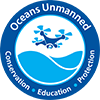Oceans Unmanned, Inc., in partnership with DARTDrones, recently trained seven NOAA ship
officers and Navigation Response Team members on drone operations at the NOAA Marine
Operations Center in Newport, OR. The successful two-day training included classroom
instruction and hands-on flights focused on vessel-based research and mapping missions.
Students practiced launch and recovery procedures, and programmed mapping missions from
the deck of the NOAA Ship Hi‘ialakai while alongside the marine facility. This training is the first
step to more broadly integrating drone operations for a variety of missions across the NOAA
fleet.
Students were trained and certified on the DJI Mavic and Phantom series, and introduced to the
larger Matrice 210RTK drones. These systems have a proven, reliable track record for being
user-friendly, and highly capable for ship and small boat launch and recovery. “We have
multiple years of experience in vessel-based drone operations supporting missions including
wildlife surveys, habitat mapping, shallow water shipwreck surveys, and more, and are excited
to assist NOAA in utilizing these systems safely and efficiently.” said Brian Taggart, Chief Pilot
of Oceans Unmanned. “These relatively inexpensive, off-the-shelf drones, have the capability
to support a wide variety of ocean and coastal environmental research projects.”
NOAA is integrating small drones aboard their survey ships for near-shore and shoreline feature
charting, by supporting or augmenting traditional shoreline verification and mapping techniques
used by hydrographic survey field units. Potential benefits of using drones for this requirement
include: improved data collection efficiency compared to data collection from small boats; more
accurate feature investigation than traditional techniques; and, most importantly, removal of
personnel from potentially dangerous situations.
The training was supported and funded by the NOAA National Geodetic Survey (NGS) Remote
Sensing Division (RSD) which has been evaluating and operating drones for several years to
meet coastal mapping requirements. “RSD has developed much of the internal policies,
procedures, and protocols necessary for safe and effective drone field operations for mapping,”
said Mike Aslaksen, Chief, NOAA Remote Sensing Division. “and we’re big supporters of
getting this technology operational across the NOAA fleet.”
Oceans Unmanned, Inc., a 501(c)(3) non-profit organization, facilitates the use of unmanned
technologies and promotes their safe and environmentally conscious operation to protect the
ocean and coastal marine environment.
MEDIA: images and video available on request
ONLINE: www.oceansunmanned.org
www.nauticalcharts.noaa.gov/updates/noaa-ship-thomas-jefferson-tests-droneuse-for-shoreline-mapping/
# # #
